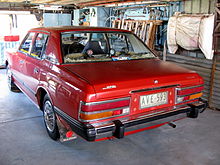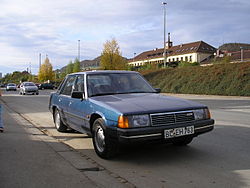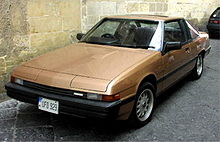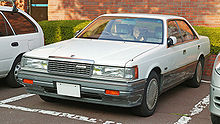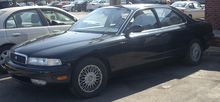- Mazda 929
-
Mazda 929 
Manufacturer Mazda Production 1973–1995 Assembly Hiroshima, Japan Successor Mazda Millenia Class Mid-size Layout FR layout The Mazda 929 (also sold as the Ẽfini MS-9) was originally a mid-size car from 1973–1987 and as a full-size car thereafter. Marketed over three decades, the 929 was originally the export name for the Mazda Luce. When equipped with a rotary engine, it was called the Mazda RX-4 in export markets. Later, after the "Luce" name disappeared in Japan, the "929" badge was applied to the succeeding Sentia for the few export markets which received the last two generations. The 929 has always been a front engined, rear wheel drive vehicle, and usually the largest sedan sold by Mazda. Station wagon versions of the first and second generations were available.
Contents
1973
First generation 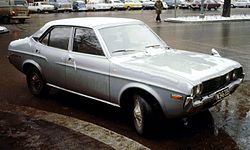
Also called Mazda Luce Production 1973–1977 Body style 2-door coupé
4-door sedan
5-door station wagonEngine 1.8 L VB I4
2.0 L MA I4
2.2 L I4 DieselWheelbase 2510 mm (98.8 in) Length 4404 mm (173.4 in) Width 1666 mm (65.6 in) Curb weight 1095 kg (2414 lb) Related Mazda RX-4 The first Mazda 929 was introduced in 1973, as an export name for the piston-engined second generation Mazda Luce, (itself introduced in autumn 1972). When equipped with a rotary engine, the car was called the Mazda RX-4. The first generation Luce had been called the "Mazda 1500" or "Mazda 1800" in export markets, but as engines of different displacement were beginning to be used across lines, such a naming philosophy would have soon become confusing. The 929/Luce was a large (for Japan) coupé, sedan, and station wagon powered by a 1.8 L (1,769 cc) inline-4 Mazda VB engine. Output was 94 hp (69 kW) and 101 N·m (137 N·m).
The Luce/929 was updated in 1975 with an optional 2.0 L (1970 cc) engine which produced 103 hp (76 kW) and 123 N·m (167 N·m) from a 2 barrel carburetor.
Engines:
- 1973-1977 1.8 L (1,769 cc) VB I4, 2 barrel, 94 hp (69 kW)/101 ft·lbf (137 N·m)
- 1975- 2.0 L (1,970 cc) MA I4, 2 barrel, 103 hp (76 kW)/123 ft·lbf (167 N·m)
1977
Second generation 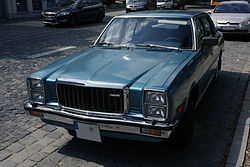
Also called Mazda Luce Production 1977–1981 Body style 4-door sedan/hardtop
5-door station wagonEngine 2.0 L MA I4
2.2 L I4 DieselRelated Mazda Cosmo The rebodied Mazda Luce Legato was introduced late in 1977 and became the second generation 929 for export markets, often called the 929L. There was no coupé version developed of this generation, although a four-door hardtop body was available in Japan and some other markets. A station wagon was added in February 1979. The design was American inspired, with stacked rectangular headlights and a large chrome grille. A more efficient 2.0 L I4, producing 90 hp (66 kW) with a single-barrel carb replaced the existing engines. First presented in Japan in October 1979 was a facelifted version with large, rectangular headlights and a more orthodox appearance. The final addition was a 2.2 L Diesel engine in September 1980. Its output was 66 hp (49 kW) and 104 N·m (142 N·m). The 929 was replaced after 1981 by the next generation Luce/929, although the second generation station wagon continued in production until the March 1988 as no estate replacement of subsequent generations was ever developed.
Engines:
- 1977-1981 2.0 L MA (1970 cc) I4, 1 barrel, 90 hp (66 kW)
- 1980-1981 2.2 L Diesel, 66 hp (49 kW)/104 ft·lbf (142 N·m)
1981
Third generation Also called Mazda Luce Production 1981–1986 Body style 2-door coupé
4-door sedan/hardtopPlatform Mazda HB platform Engine 2.0 L MA I4
2.0 L FE I4Related Mazda Cosmo The next generation 929 was introduced to Japan in October 1981 as the Mazda Luce. It was a large front-engine rear-wheel drive sedan or coupé on the new HB platform, which was now shared with the Mazda Cosmo. This version was introduced as the 929 in 1982 in most export markets and produced until 1986, though Japan got a new Luce a year earlier. Luces and Cosmos received several differing front end treatments, with export 929s receiving the very staidest front end designs for 929 sedans and the sportiest flip-up headlight "Cosmo" design for 929 Coupés.
In Europe the 929 was badged 2000 or 2000E (E denoting "estate car"; applied to a facelifted version of the previous generation). The turbo version was never offered in Europe, and neither was the four-door hardtop, although parts of Europe bordering on Eastern Europe and the Middle East did receive it. In Cyprus both the sedan and estate car versions were offered.
Engines:
- 1981-1986 2.0 L (1,970 cc) MA I4, 1 barrel, 90 hp (66 kW)/118 ft·lbf (160 N·m)
- 1981-1986 2.0 L (1,998 cc) FE I4, 2 barrel, 101 hp (74 kW)/115 ft·lbf (156 N·m)
- 1981-1986 2.0 L (1,998 cc) FE I4, FI, 118 hp (87 kW)/126 ft·lbf (171 N·m)
- 1986-1987 2.0 L (1,998 cc) FET I4, FI, turbo, 120 hp (89 kW)/150 ft·lbf (203 N·m)
1986
Fourth generation 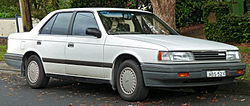
Pre-facelift Mazda 929 sedanAlso called Mazda Luce Production 1986–1991 Body style 4-door sedan Platform Mazda HC platform Engine 2.0 L FE I4
2.2 L F2 I4
2.0 L JF V6
3.0 L JE V6Transmission 5-speed manual
4-speed automaticWheelbase 2,710 mm (106.7 in) Length 4,690–4,930 mm (184.6–194.1 in) Width 1,695–1,725 mm (66.7–67.9 in) Height 4,690–4,930 mm (184.6–194.1 in) The 929 was updated in 1986 (1987 in some markets) with the HC platform and a 3.0 Liter V6 engine. The car was produced through 1991, again lagging behind its Japan-market twin, the Mazda Luce, by one year. The 929 began U.S. and Canadian sales in 1988; although predominantly available as a 3.0 Liter V6, there were a rare few that made it to the North American market as a 4 cylinder 2.2 F2 in a RWD configuration. After 1990, when Chrysler dropped its Fifth Avenue and Dodge Diplomat (both of which had 318 cubic inch V8 engines) it would exclusively rival the Toyota Cressida until Toyota dropped the car after 1992.
The HC platform came out in two variations during its five year span that had identical engines and interior but with two distinct body shapes; a pillared four-door sedan as well as a slightly larger pillarless four-door hardtop. While the pillared model was common in all countries that allowed the importation of the 929 (including the US and Canada), the pillarless model was predominantly seen in the Asian, and Australian markets.
The Luce Royal Classic (and lesser-spec Limited) was more expensive than its 929 counterpart, featuring greater technical innovation — both were pillarless hardtops. The Royal Classic was factory fitted with a turbocharged 13B Rotary or 2.0 Litre V6 engines, electric leather seats, digital speedometer, a cool-box for canned beverages, prominent emblems, electronically adjustable suspension and power options throughout.
The Canadian 929 came with a 'Winter Package' option and included heated seats, a higher grade alternator, winter tires and non-recessed windshield wipers. A five-speed manual gearbox was an option, but most North American 929s were two-mode ('power' and 'economy') electronic 4-speed automatics. Top speed was 121 mph (195 km/h). A 0-60 mph time of 9.2 seconds was recorded using the manual gearbox; the automatics were somewhat slower at 10 seconds.
The first 3.0 Litre V6 engine seen in the 1986-1989 929 was a Single Overhead Cam type with 18 valves. When Mazda released the higher-spec 929S model for the 1990-1991 period, the engine was upgraded to a Double Overhead Cam type with 24 valves, slightly increasing fuel economy, performance and reliability. Also in the revised edition came the presence of an anti-lock braking system, ventilated rear disc brakes and a few inconspicuous changes to the exterior. The standard 18 valve SOHC remained in the base model 929.
Engines:
- 1986-1990 2.0 L (1,998 cc) FE I4, 1 barrel, 82 hp (60 kW)/152 Nm
- 1986-1990 2.0 L (1,998 cc) FE I4, FI, 116 hp (85 kW)/121 ft·lbf (164 Nm)
- 1986-1990 2.2 L (2,184 cc) F2 I4, 1 barrel, 115 hp (85 kW)/129 ft·lbf (175 Nm)
- 1986-1990 2.2 L (2,184 cc) F2 I4, FI, 127 hp (93 kW)/141 ft·lbf (192 Nm)
- 2.0 L JFT V6, FI, 110 hp (81 kW)/171 Nm
- 2.0 L JFT V6, FI turbocharged, 146 hp (107 kW)/235 Nm
- 1986-1991 3.0 L (2,954 cc) JE V6, FI, 158 hp (121 kW)/182 ft·lbf (247 Nm)
- 3.0 L JE V6, FI, 190 hp, 191 lb·ft (259 N·m)
1990
Fifth generation 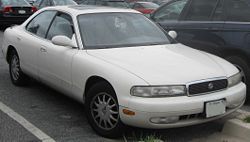
Also called Mazda 929 Serenia
Mazda Sentia
Ẽfini MS-9
Amati 1000
Amati 1200Production 1991–1996 Body style 4-door sedan Platform Mazda HD platform Engine 2.5 L J5 V6
3.0 L JE V6
3.0 L JE-ZE V6Transmission 4-speed automatic Wheelbase 112.2 in (2,850 mm) Length 193.7 in (4,920 mm) Width 70.7 in (1,796 mm) Height 54.9 in (1,394 mm) Designer Dori Regev The HD generation of the 929 appeared in 1990, with the smaller four cylinder engines dropped in favour of V6 engines only. It was sold as the Ẽfini MS-9 under Mazda's ill-fated diversification plan. There was no longer a Luce rotary version, and the Cosmo got a new platform as well. A new model, the Sentia, appeared on the same platform. In Canada, the car was known as the 929 Serenia.
The Mazda 929 was available with ABS, full electrics, cruise, 4WS, 4WD (in some markets), as well as a 'solar vent' that vents the heat from the car.
The Sentia continued for one more generation, but importation of the 929 to North America stopped in 1995 with the front-wheel drive Mazda Millenia remaining at the top of the company's lineup. The 929 was withdrawn from North America due to a lack of interest in non-luxury brand Japanese imports of this size, evidenced by the withdrawal of the Toyota Cressida in 1992. For North America, it was the last remaining mainstream rear-wheel drive sedan with a V6 engine, though smoother straight-six designs continued in European cars until the Chrysler 300 was unveiled in 2005.
During the early 1990s Mazda had considered introducing its own luxury brand, Amati, to compete with Lexus, Infiniti and Acura but later withdrew their plans. The 929 was replaced by the Mazda Millenia as the flagship sedan, but the Millenia is front-wheel drive. 929 Serenia sales ended in Canada after the 1994 model year, and the United States followed suit in the 1995 model year.
Engines:
- 2.5 L J5 V6
- 3.0 L (2,954 cc) JE V6, SOHC, 160 hp (118 kW)/180 ft·lbf (245 N·m)
- 3.0 L (2,954 cc) JE26 V6, DOHC, 205 hp (151 kW)/200 ft·lbf (272 N·m)
1996
Sixth generation 
Also called Mazda Sentia Production 1996–1997 Body style 4-door sedan Platform Mazda HE platform Engine 3.0 L JE-ZE V6 Transmission 4-speed automatic Wheelbase 112.2 in (2,850 mm) Length 193.7 in (4,920 mm) Width 70.7 in (1,796 mm) Height 54.9 in (1,394 mm) Designer Dori Regev The final HE generation of the 929 appeared in Australia in April 1996. The engine remained a carry-over, and the dimensions of the vehicle were identical to the previous model. Production remained short; exports were halted in 1997 due to poor sales and an increasingly high price tag (in its final year the 929's price had increased to over $83,000 in the Australian market - about the same price as an entry-level BMW 5-Series).
Engines:
- 3.0 L (2,954 cc) JE26 V6, DOHC, 138 kW (185 hp)/270 N·m
External links
- 1992-95 Mazda 929 info at Consumer Guide
« previous — Mazda road car timeline, 1990s–present Type 1990s 2000s 2010s 0 1 2 3 4 5 6 7 8 9 0 1 2 3 4 5 6 7 8 9 0 1 Kei car Carol Carol Carol Carol Carol AZ-Wagon AZ-Wagon AZ-Wagon AZ-Wagon AZ-Offroad Spiano Scrum Scrum/Scrum Wagon Scrum/Scrum Wagon Subcompact Revue/121 Demio/121 Demio/Mazda2 Demio/Mazda2 Verisa Compact Familia/323/Protegé Familia/323/Protegé Familia/323/Protegé Axela/Mazda3 Axela/Mazda3 Familia Van Familia Van Familia Van Mid-size Capella/626 Capella Capella/626 Atenza/Mazda6 Atenza/Mazda6 Cronos/626/Xedos 6/Eunos 500 Eunos 800/Xedos 9/Millenia Mazda6 (N.America) Full-size Sentia/929/Efini MS-8 Sentia Sports car AZ-1 MX-3 Precidia Roadster/MX-5/Miata Roadster/MX-5/Miata Roadster/MX-5 MX-6/Mystère MX-6/Mystère/Efini MS-6 RX-7 Efini RX-7/RX-7 RX-8 Cosmo Minivan Premacy Premacy/Mazda5 Premacy/
Mazda5Bongo Friendee Biante Efini MPV/MPV MPV MPV/Mazda8 Crossover CX-7 CX-9 SUV Navajo Tribute Tribute Pickup B-Series B-Series B-Series BT-50 BT-50 Van Bongo Bongo Mazda automobile timeline, North American market, 1980s–present Type 1980s 1990s 2000s 2010s Model year 0 1 2 3 4 5 6 7 8 9 0 1 2 3 4 5 6 7 8 9 0 1 2 3 4 5 6 7 8 9 0 1 Subcompact GLC GLC Mazda2 323 323/Protegé Compact Protegé Protegé Mazda3 Mazda3 626 626 626 Mid-size 626 626 Mazda6 Mazda6 Millenia Full-size 929 929 Sport compact MX-3 MX-6 MX-6 Sports MX-5 Miata MX-5 Miata MX-5 RX-7 RX-7 RX-7 RX-8 Minivan Mazda5 MPV MPV Mid-size crossover CX-7 Full-size crossover CX-9 SUV Navajo Tribute Tribute Pickup B-Series B-Series B-Series B-Series References
Categories:- Mazda vehicles
- Rear wheel drive vehicles
- Luxury vehicles
- Mid-size cars
- Sedans
- Full-size vehicles
- Vehicles with four wheel steering
- Vehicles with Wankel engines
- 1970s automobiles
- 1980s automobiles
- 1990s automobiles
- Vehicles introduced in 1973
Wikimedia Foundation. 2010.

